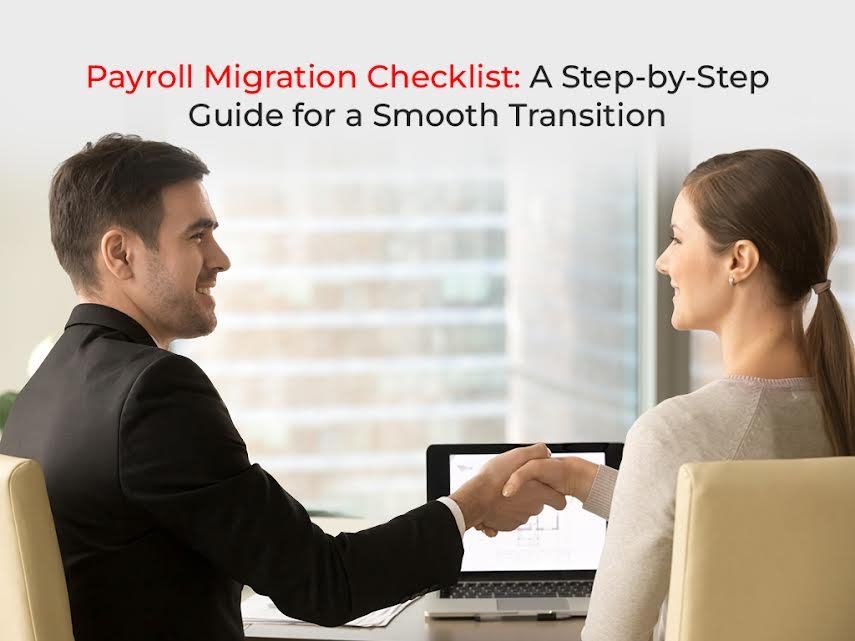Companies often migrate to new payroll systems to improve efficiency, increase compliance, and better integrate with HR and finance equipment. However, parole migration is a complex process that requires careful planning and execution. If not done correctly, it can give birth to payroll errors, compliance issues, and disgruntled employees.
At Growel Softech, we recognize the challenges facing businesses during payroll migration and are here to help organizations transition smoothly. In this article, we provide a comprehensive payroll migration checklist to ensure a smooth, error-free transition to your new payroll system.
Why Payroll Migration Is Important
Payroll is the backbone of any business, ensuring that employees are accurately and timely compensated. A payroll migration process includes payroll data, employee records, and transfer tax details from one system to another. Companies include the payroll system for general reasons:
- Automatic payroll processing management
- Upgrade to the more advanced cloud-based payroll system
- Ensure better compliance with tax and labor laws
- Integration of payroll with HR and accounting software
- Reduce processing time and operational costs
However, migrating payroll data is not without risk. Data transfer, wrong tax calculation, and errors in security weaknesses can disrupt business operations. This is why it is necessary to have a structured parole migration checklist.
Payroll Migration Checklist
Step 1: Define Your Payroll Migration Goals
Before starting the migration process, businesses must identify their payroll needs and migration objectives. Key considerations include:
- Limitations of the current payroll system
- Whether the new system is cloud-based or on-premises
- Required features such as automated tax filing, multi-currency payments, or AI-driven analytics
- Compliance requirements for local and international tax laws
Having clear goals helps in selecting the right payroll system and aligning migration strategies accordingly.
Step 2: Choose the Right Payroll Software
Selecting a payroll system is a critical decision. The new payroll solution should offer:
- Scalability to accommodate business growth
- Integration with HR, finance, and accounting tools
- Compliance with local and international tax laws
- Strong data security features, including encryption and access controls
- Automation capabilities for tax deductions, benefits, and overtime calculations
Step 3: Conduct a Payroll Data Audit
Before migrating payroll data, it is essential to review and verify all employee records to eliminate errors. A thorough payroll audit should include:
- Employee details such as name, job title, salary structure, and benefits
- Tax-related information, including PAN, Aadhaar, TIN, ESIC, and PF
- Attendance records, overtime, and leave balances
- Compliance-related deductions such as TDS, professional tax, and gratuity
Identifying discrepancies early can prevent payroll errors post-migration.
Step 4: Backup Payroll Data Before Migration
Data security should be a top priority during payroll migration. Before initiating data transfer, ensure secure backups of all payroll records using:
- Cloud-based storage for easy recovery and access
- Encrypted external hard drives or secure servers
- Multiple backup versions stored in different locations
Having backups mitigates data loss risks during the transition.
Step 5: Data Mapping – Align Old and New Payroll Systems
Every payroll system has a unique data structure. To ensure a smooth migration, the new system must correctly interpret employee records, salary components, and tax details. Key areas for data mapping include:
- Employee IDs and designations
- Salary structures, including basic salary, bonuses, deductions, and benefits
- Attendance, leave balances, and overtime pay
- Tax deductions such as PF, ESIC, and TDS
Failure to map data accurately can lead to salary miscalculations and compliance issues.
Step 6: Test the Payroll System in a Sandbox Environment
Before rolling out the new payroll system, conducting a test migration in a sandbox environment allows businesses to:
- Identify data transfer errors
- Validate salary calculations and tax deductions
- Generate test payroll reports for accuracy verification
Running tests minimizes risks and ensures the new payroll system is ready for deployment.
Step 7: Train HR and Finance Teams on the New Payroll System
Switching to a new payroll system requires adequate training for HR and finance teams. Training should include:
- Live demonstrations of payroll processing
- Hands-on practice sessions
- Q&A sessions with payroll experts
Providing detailed training materials helps employees adapt quickly to the new system.
Step 8: Run Parallel Payroll for Accuracy Checks
To avoid payroll errors, businesses should run parallel payroll processing for at least one or two payroll cycles. This means processing payroll in both the old and new systems and comparing the results. Key checks include:
- Salary accuracy to ensure employees receive the correct amount
- Tax consistency to verify correct deductions
- Compliance verification to meet statutory regulations
Parallel testing identifies discrepancies before full deployment.
Step 9: Communicate the Changes to Employees
A new payroll system may introduce changes in payslips, tax deductions, or salary structures. It is crucial to inform employees about the transition through:
- Company-wide emails detailing the migration process
- FAQs to address employee concerns
- Dedicated support teams to handle queries
Step 10: Go Live and Monitor Performance
After successful testing and training, the new payroll system can be officially deployed. However, continuous monitoring is necessary to track:
- Payroll accuracy in the first few months
- Employee feedback and resolution of any issues
- Tax compliance and reporting requirements
Regular system audits and performance reviews help maintain a flawless payroll process.
Common Challenges in Payroll Migration (and How to Overcome Them)
Despite careful planning, payroll migration may face hurdles. Here’s how to tackle them:
- Data inconsistencies: Conduct a thorough payroll audit before migration
- System integration issues: Choose a payroll system with API integrations
- Employee resistance: Provide training and transparent communication
- Compliance errors: Work with payroll specialists and consultants
Final Thoughts
Payroll migration is a critical process that requires careful planning, testing, and monitoring. By following this comprehensive payroll migration checklist, businesses can avoid payroll errors, ensure compliance, and improve efficiency.
At Growel Softech, we specialize in HR technology solutions and provide expert guidance on payroll migration. Whether you need assistance with payroll automation, system integration, or compliance management, our team is here to support you.
For a seamless payroll transition, contact Growel Softech today for a consultation. Let us help you streamline your payroll processes with confidence.


